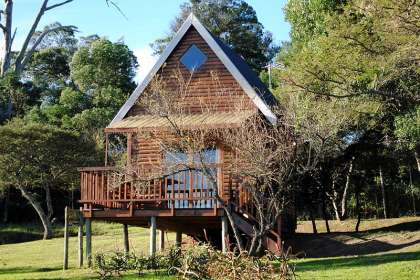St Patrick's Church
Throughout the 1820's and 1830's there were a significant number of Catholics
living in the Eastern Cape. Some were early settlers, and some were soldiers,
but the the local Catholics had no priests to minister to their spiritual needs
until the arrival of Bishop Griffith and Father Burke in Grahamstown in 1838. On
Sunday 15 July 1838 the Bishop celebrated mass in Widow Mahoney's house, which
was near the site of the present church. When the Bishop left in August of 1838,
Father Burke reluctantly stayed behind to establish a mission centre. The long
distances of up to a 150 miles, which Father Burke had to travel to reach his
congregation, proved to be too physically demanding and time consuming for the
priest and assistance was sent to Grahamstown in the form of a Father Murphy,
recently ordained priest from St. Peter's College. Wexford. A short time after
the arrival of Father Murphy, Father Burke died in his sleep. A number of the
locals had suspected that Father Murphy played a part in Father Burke's death,
however he continued with his work, and soon became known all over the Eastern
Cape.
Serving as a catholic military chaplain, Father Murphy formed a close
relationship with the 27th Inniskillings Regiment, who later helped with the
construction of the St. Patrick's Church. The design of the church was provided
by Major Selwyn who was the Commanding Engineer in the Eastern Cape, and the
plans were drawn up by Mr Teeling, a clerk in the Royal Engineers. Indeed the
Church, with its many castle-like battlements, shares a resemblance with Major
Selwyn's Gothic Castle in Prince Alfred Street. The foundation stone was laid in
July of 1839, and July of 1844, the church was consecrated by Bishop Griffiths
and a large congregation which included the Lieutenant Governor, various civil
and military officials and prominent citizens of Grahamstown.
A number of people have noticed a resemblance between the St Patrick's Church and
Battle Abbey in Hastings, in England, which both display a strong military
character. The old solid stone building which stands in Hill Street in
Grahamstown, provided protection to people of the area, which included pupils of
the Assumption Convent, who sought safety there during the Frontier Wars of 1846
and 1851. The Sisters of the Assumption Convent still stands at St. Patrick's
today.
1847 saw St Patrick's Church being raised to the status of pro-cathedral, and
the promotion of Bishop Aidan Devereaux to Vicar Apostolic of the Eastern
Districts of the Cape. Bishop Devereaux was succeeded by Bishops Moran and
Ricards, and when Bishop Strobino succeeded Bishop Ricards in 1839, he moved the
seat of the Episcopacy to Port Elizabeth. Ricards ,with his friend Dr.
Atherstone, was one of the men responsible for the identification of the first
diamond discovered at the Cape in 1867, and the pane of glass on which he
inscribed his initials can bee seen in the Observatory Museum. The diamond,
known as the Eureka diamond is now kept in the Houses of Parliament in Cape
Town. Bishop Ricards was also responsible for selecting the High Altar of St
Patrick's Church, which was bought during a visit to Paris in 1886.
Accommodation Near St Patrick's Church
1 on Ross
Self Catering House, Cottage, Chalet Accommodation in Grahamstown
1km from St Patrick's Church1 on Ross consists of three cottages nestled in a quiet cul-de-sac just off Henry Road. It has a beautiful garden which featured in the Gardens of Grahamstown show, pool and offers braai facilities. …see more for bookings / enquiries and info.
Jenny's B&B
Bed & Breakfast Accommodation in Grahamstown
1.6km from St Patrick's ChurchExperience warm South African hospitality with home from home comforts at Jenny's B&B. Situated in a tranquil suburb in Grahamstown, heart of Settler country, with a picturesque garden, perfect for a restful stay. …see more for bookings / enquiries and info.
A Stone's Throw
Bed & Breakfast Accommodation in Grahamstown
4.4km from St Patrick's ChurchFreedom is a stone's throw away...stunning sunsets - country garden setting - spectacular views - bird lover's delight - swimming pool - scenic walks - children welcome. Warm Eastern Cape Hospitality! …see more for bookings / enquiries and info.




